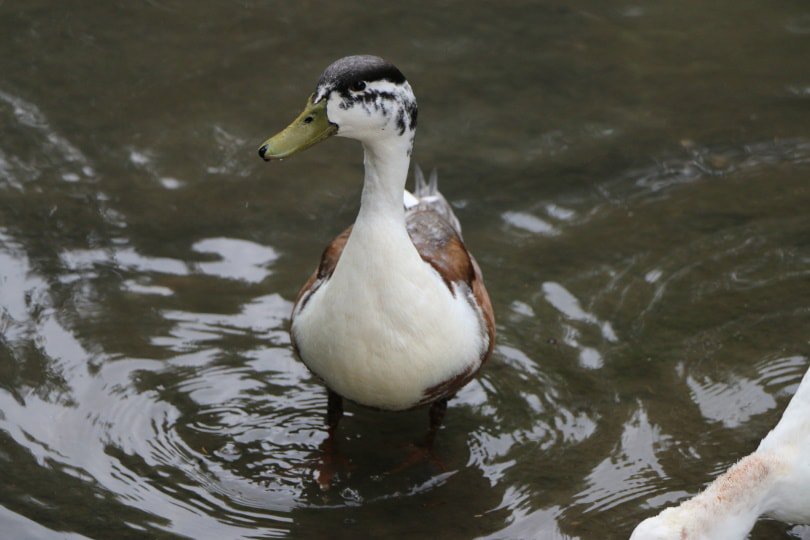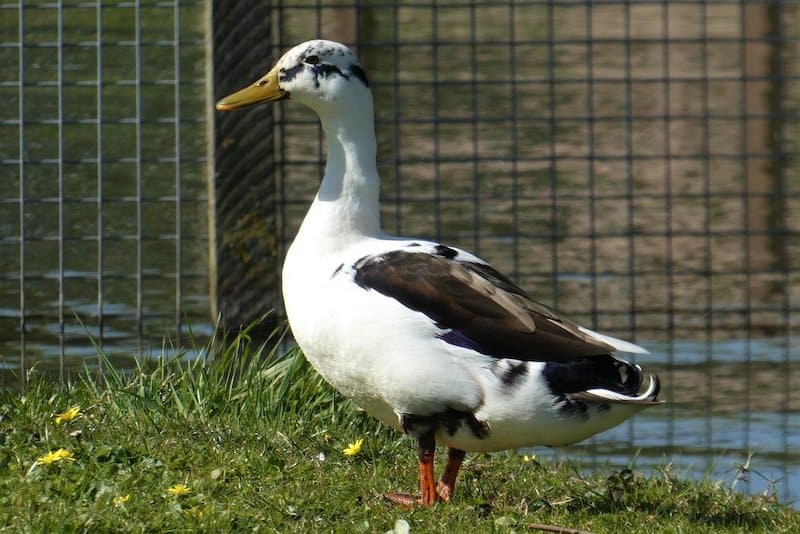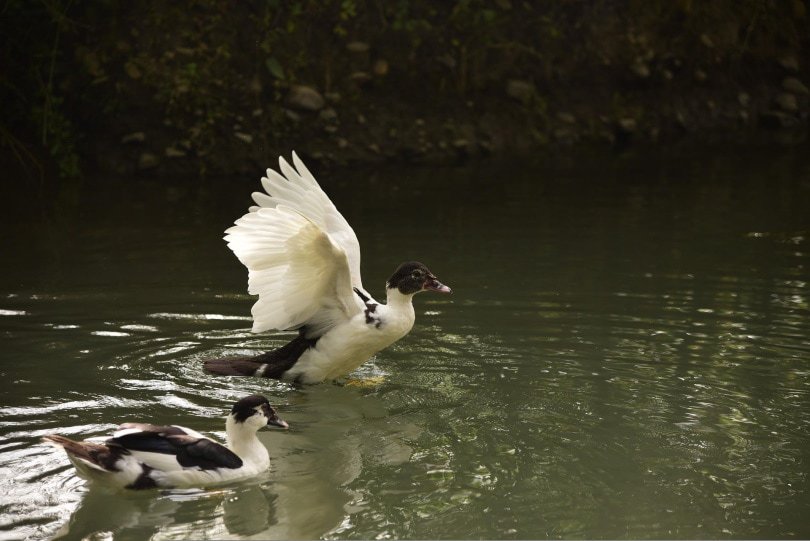The Magpie duck is known for their small size and distinctive black and white plumage. This is a very hardy and adaptable breed of duck that has been domesticated and widely used for their eggs and meat or kept as pets for display purposes. You will find that the Magpie duck is generally considered to be friendly and is an excellent breeder and egg layer.
This well-known breed can live up to 12 years of age if cared for properly and is selected as pets or for their products depending on their coloration, temperament, and health status. If you are interested in learning more about the Magpie duck, then read on below for more information!

Quick Facts about Magpie Ducks

| Breed Name: | Magpie |
| Place of Origin: | Wales |
| Uses: | Meat, eggs, pets |
| Drake (Male) Size: | 5 pounds |
| Hen (Female) Size: | 4.5 pounds |
| Color: | White, black, blue |
| Lifespan: | 8–12 years |
| Climate Tolerance: | All seasons |
| Care Level: | Easy |
| Production: | Eggs |
Magpie Duck Origins
The Magpie duck did not originate from a wild habitat but was instead bred to be the attractive and friendly duck you find today. They were first bred by M.C Gower-Williams and Oliver Drake in Yorkshire in the 1900s. These two Welsh breeders crossbred a Belgium Huttegem and Indian Runner duck for their plumage patterns and size, which then resulted in the Magpie duck breed.
It was Isaac Michigan who then brought this breed to the United States back in 1963, only a century after this breed was created. Several years later, the American Poultry Association (APO) recognized the Black Magpie and accepted the blue variations some years later.
The first-ever documentation of the Magpie duck was back in the 1920s, and a breeders appreciation club for the Magpie duck was then created only 6 years later. This duck breed may have a lengthy history, but they are now widely owned either as pets or used for their egg and meat production.

Magpie Duck Characteristics
The Magpie duck has a few noteworthy characteristics that entice duck lovers to keep them. This duck breed cannot fly, and instead, only flap its wings and glide several feet in the air, so owners do not have to worry about this duck breed flying away. This makes them easier for you to raise because you do not have to keep them in an enclosed space unless you are securing them from predators, as they will not migrate like other duck breeds.
They have an average lifespan of 8 to 12 years and do best when kept in captivity because they cannot thrive in the wild. Since the Magpie duck was first bred in Wales which goes through all four seasons, the Magpie duck can survive in various climate conditions if it does not get too hot or cold for them. This hardy breed can survive in all climates, which makes them a popular choice for many duck owners.
Their diet is quite easy to provide, as they mainly eat insects and seeds found in grassy areas, while some will even eat small insects and fish found in ponds and puddles that they have access to. The Magpie duck can also be fed standard poultry food or game bird food as a staple, which is especially important for their protein intake in colder weather where they will need more body fat to keep warm.

Uses
Most duck owners will choose Magpies for their hardiness and the very few health issues that are associated with this breed. They have a history of good egg production, but many duck lovers will struggle to raise these ducks for food once they have gotten to raise this friendly breed!
Their prolific egg-laying abilities make them a good breed to raise for the egg trade and the hens can lay up to 220 to 280 eggs a year if they are kept healthy. If you are looking to raise Magpie ducks for their meat, then it should be noted that they are regarded to have high-quality meat that has a good flavor and texture.
Appearance & Varieties
The Magpie is an attractive breed of duck that has a white body with either black or blue markings on the crown of their heads, tails, and along their backs. Their feet and bills are bright oranges, and many varieties of Magpie ducks have a dark pattern on the top of their head. Their coloration can be seen from when they are hatchlings as the pattern will stay the same as they start to mature.
They have a relatively small body, with the long and slender shape of the Indian Runner duck, with a defined neck and broad heads. Most female Magpie ducks are smaller than their male counterparts, which is why they weigh slightly less.
All adult Magpie hens will have straight tail feathers, whereas the drakes will have curly feather tails that can be seen once this breed reaches 10 weeks of age. This will help you determine whether your Magpie duck is male or female.

Population/Distribution/Habitat
The Magpie duck is most popular within the United States and its land of origin in Wales. However, since they are a man-made duck breed, they do not have a natural habitat and if they are released into the wild, they are not likely to thrive or reproduce as well as they would in captivity.
This duck breed is also considered to be critically endangered according to the American Livestock Breed Conservancy, so it is important to not release this breed into the wild where it will not thrive. Their endangered status has also increased the amount of Magpie duck breeders in the United States, and care should be taken to produce healthy Magpie lineages.

Are Magpie Ducks Good for Small-Scale Farming?
Magpie ducks are great for small-scale farms, and many farmers will keep this breed of duck on their land because they eat the pests such as snails, slugs, mosquito larvae, and insects that may affect their crops or other animals. You can keep these ducks in small or large groups, and they will breed comfortably in the right conditions and under the right care to provide you with companionship, meat, or eggs.
Featured Image Credit: Ramesh Bhandari, Pixabay
